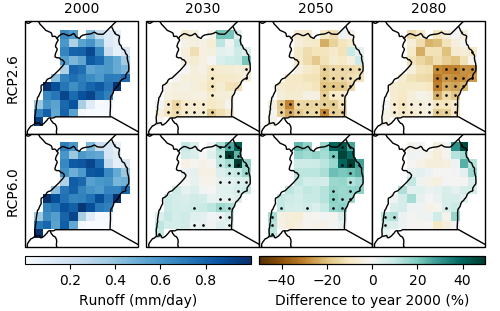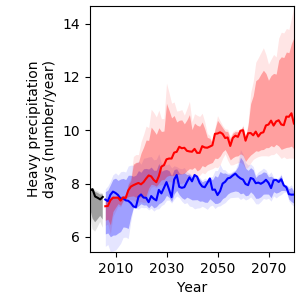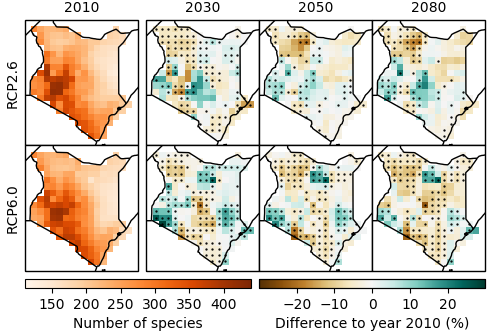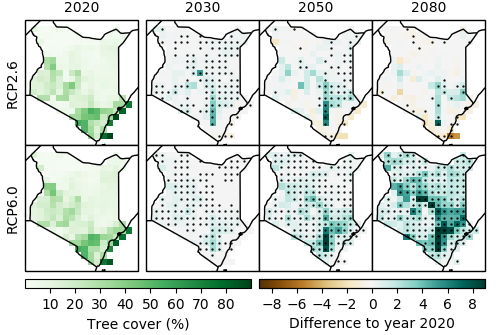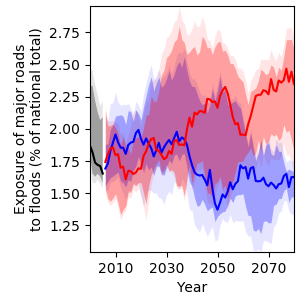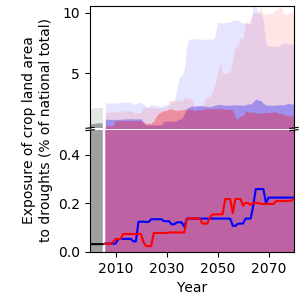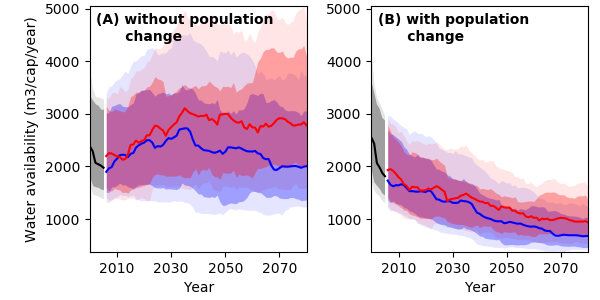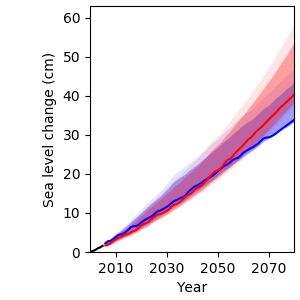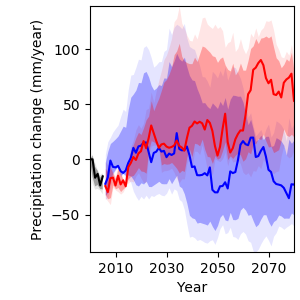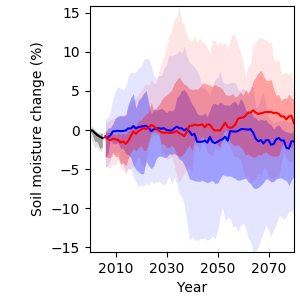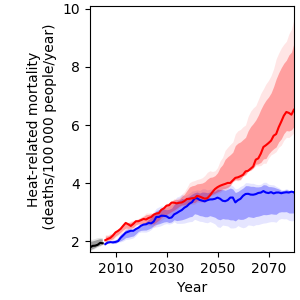Smallholder farmers in Uganda are increasingly challenged by the uncertainty and variability of weather that climate change causes [19], [20]. Since crops are predominantly rainfed, they depend on water availability from precipitation and are prone to drought. However, the length and intensity of the rainy season is becoming increasingly unpredictable and the use of irrigation facilities remains limited due to high operation costs, limited extension services and problems regarding irrigation management [21]. Currently, only 0.5 % of the national crop land suitable for irrigation (3.03 million hectares) is irrigated [7]. The main irrigated crop is rice, followed by sugar cane, maize and vegetables [21].
Crop land exposure to drought
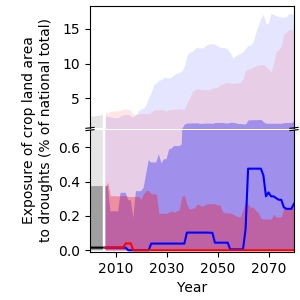
Currently, the high uncertainty of projections regarding water availability (Figure 9) translates into high uncertainty of drought projections (Figure 10). According to the median over all models employed for this analysis, the national crop land area exposed to at least one drought per year will hardly change in response to global warming. However, there are models that project a strong increase in drought exposure. Under RCP2.6, the likely range of drought exposure of the national crop land area per year widens from 0–0.4 % in 2000 to 0–1.7 % in 2080. The very likely range widens from 0–2.3 % in 2000 to 0–17.1 % in 2080. This means that some models project up to a tenfold increase in drought exposure over this time period, while others project no change.
Crop yield projections

Climate change will have a negative impact on yields of maize, millet and sorghum (Figure 11)5. While maize is sensitive to hot temperatures above 35 °C, millet and sorghum tolerate hot temperatures and dry periods better [22]. Still, model results indicate a negative yield trend for all three crops under both RCPs. Compared to the year 2000, amounts are projected to decline by 6 % for maize and 13 % for millet and sorghum by 2080 under either RCP. Yield projections for groundnuts and cassava vary depending on the scenario. Under RCP2.6, yields are projected to decline by 7 % for groundnuts and 12 % for cassava. Under RCP6.0, groundnut yields are projected to gain from climate change with an increase of 4 %, while cassava yields are projected to decline by 2 % by 2080 relative to the year 2000. The decrease under RCP2.6 can be explained by non-temperature related parameters such as changes in precipitation, while the RCP6.0 results can be explained by the CO2 fertilisation effect under higher concentration pathways. Groundnuts and cassava are so-called C3 plants, which follow a different metabolic pathway than maize, millet and sorghum (C4 plants), and benefit more from higher CO2 concentration.
Overall, adaptation strategies such as switching to improved varieties in climate change sensitive crops should be considered, yet carefully weighed against adverse outcomes, such as a resulting decline of agro-biodiversity and loss of local crop types.
5 Modelling data is available for a selected number of crops only. Hence, the crops listed on page 2 may differ. Maize, millet and sorghum are modelled for all countries.
References
[7] Ministry of Agriculture Animal Industry and Fisheries and Ministry of Water and Environment, “National Irrigation Policy: Agricultural Transformation Through Irrigation Development,” Entebbe, Uganda, 2017.
[19] F. M. Mwaura and G. Okoboi, “Climate Variability and Crop Production in Uganda,” J. Sustain. Dev., vol. 7, no. 2, pp. 159–172, 2014.
[20] V. Sridharan, E. P. Ramos, E. Zepeda, B. Boehlert, A. Shivakumar, C. Taliotis, and M. Howells, “The Impact of Climate Change on Crop Production in Uganda: An Integrated Systems Assessment With Water and Energy Implications,” Water, vol. 11, pp. 1–24, 2019.
[21] J. Wanyama, H. Ssegane, I. Kisekka, A. J. Komakech, N. Banadda, A. Zziwa, T. O. Ebong, C. Mutumba, N. Kiggundu, R. K. Kayizi, D. B. Mucunguzi, and F. L. Kiyimba, “Irrigation Development in Uganda: Constraints, Lessons Learned and Future Perspectives,” J. Irrig. Drain. Eng., vol. 143, no. 5, pp. 1–10, 2017.




